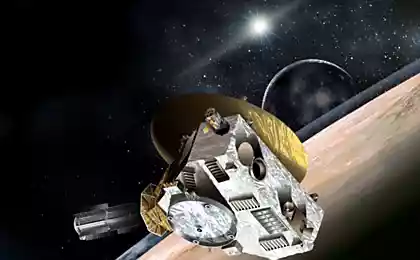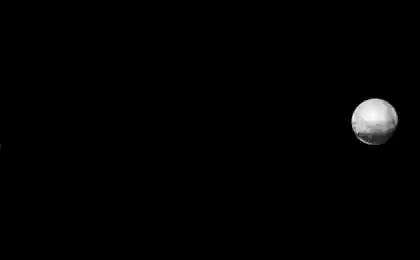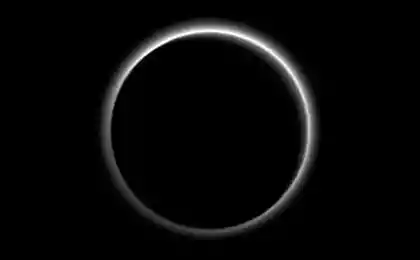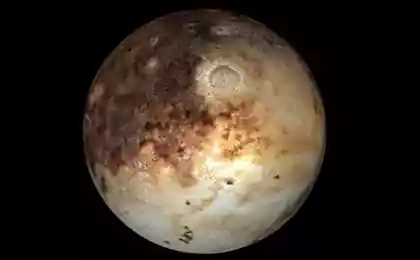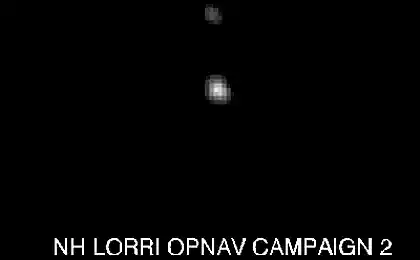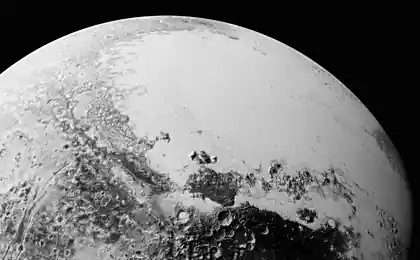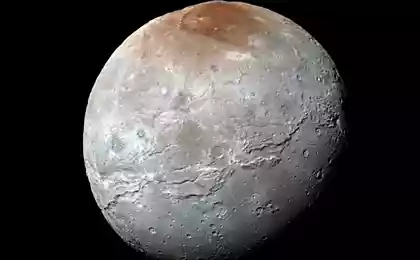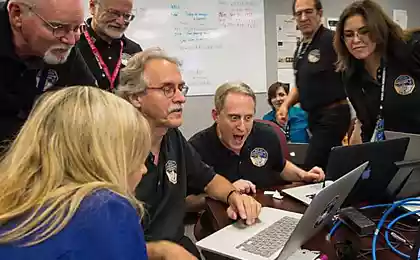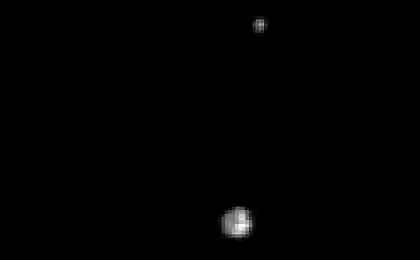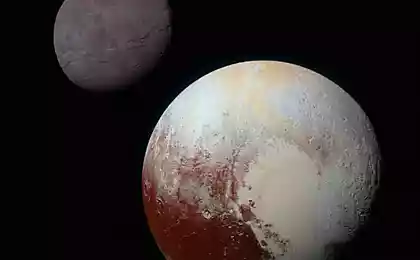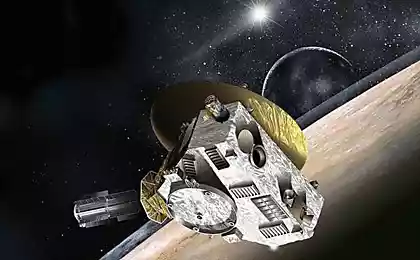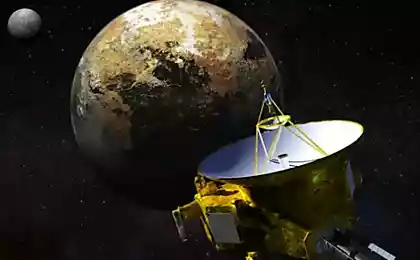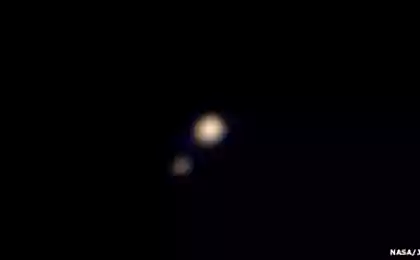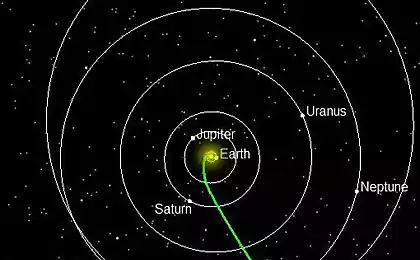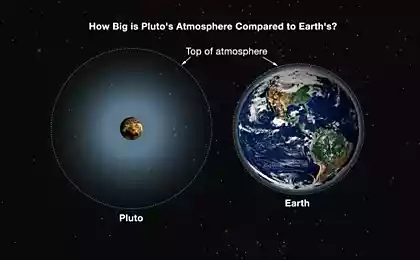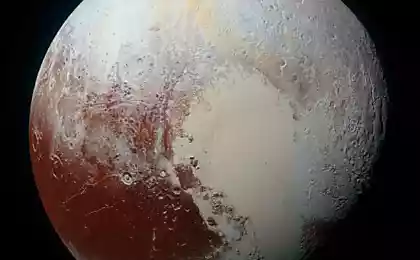1353
Mysteries of the Pluto-Charon
August 24, 2006, Pluto was excluded from the list of planets in the galaxy, and recently, scientists announced the possibility of the existence of life forms that are close to the earth, in the binary system Pluto-Charon. Preliminary conclusions have been drawn from the images of the probe "New Horizons", is already very close to podletevshego double planet.
Pluto with Charon, there are other, no less interesting puzzle. Let's try to understand them.
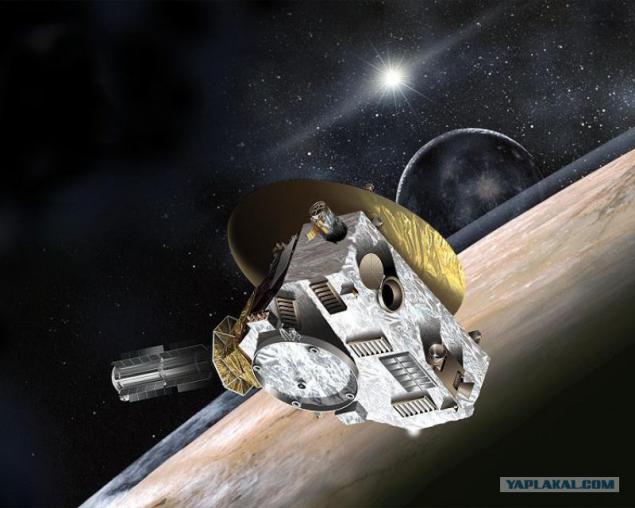
Is there life after "the Moscow Ring Road" Galaxy?
Less than eleven months away earthly meeting of the American probe "New Horizons" with the Pluto-Charon system. Video made at the end of July this year, allowed to adopt a hypothesis: Pluto and Charon - single planetary system barycenter is both planets. Charon moves around much "dance" of Pluto, for which the interaction of celestial bodies called orbital dance. Confirmed the theoretical calculation that the distance between Pluto and Haronom- only 18 000 kilometers, on space standards - minuscule! For example, the moon 13 times farther away from our Earth.
5 days until Charon is almost entirely made one orbit around Pluto, the probe apparatus made of 12 images. According to him much - Charon (about 12 percent by weight of Pluto) exerts a strong gravitational influence on the partner, and the "dancing". That is, the two objects revolve around the imaginary point in space - their barycenter. More in 2012 published the results of research: four satellite systems do not revolve around Pluto, and circling in orbit around the center of gravity of the double planet Pluto-Charon. Now the scientific world froze in anticipation of the planned approach to the probe system in July 2015, in order to understand - whether to return the status of Pluto a planet or to award the status of the binary system.
In 2006, there were those versions, if not to rank and rank as the planets in the parameter "zaneptunya" (Pluto turned out beyond Neptune and "expelled" from the solar system), there is a possibility of non-recognition planet celestial body with humanoid life. So what. "New Horizons" may challenge the status of the binary system, and on this basis! Yes, Pluto from the sun more than the Earth 29 times. The temperature on the surface - minus 229 degrees Celsius, it is a permanent clot most deep cold in the solar system. That is, for us it is through mёrzly world of ice and stone. However, the cold nature of Charon cracks ice cap has convinced some researchers in the existence of the warm ocean under a thick crust. Assumptions powerful tides they explained probability warming ocean underwater volcanoes. And where the warm ocean, and there biozhizn, many believe.

Where strays Plutoid
Pluto is smaller than all hung around the planet - it opened last in 1930, astronomer Clyde Tombaugh, and after 76 years deprived of the title. The word "planet" means - the wandering light. Pluto "downgraded" to the dwarf planet, something like wandering lantern, probably. During his debunking ranked as the Kuiper belt objects, and in 2008 was named Plutoid, enter a new name for the objects similar to Pluto. But he was not always so far from the sun. Pluto-Charon's orbit is unusual, sometimes the system is removed at 49 astronomical units (49 distances from the Earth to the Sun), but sometimes it is not beyond Neptune - at a distance of 29 astronomical units. So close to the Sun binary planet approached during the 1979-1999 period. The next time our heavenly dancers will be so close to catch a few hundred years.
Speaking of his companions did not know many decades. Until 1978, no one was puzzled why the image of Pluto - elongated spot? And it merged silhouettes very close Pluto and Charon, divide them only managed interferometric techniques. Later on, one after another, opened four satellite system.
In 1985, astronomers have seen has an atmosphere of Pluto. This is evidenced by the observation that when Pluto passes in front of the star, dimming the star appears before it comes to Pluto, it overrides the visibility of its shell. She had a weirdo - consists of nitrogen, methane and carbon dioxide, when the object is removed enough from the Sun, it freezes on the surface when an object approaches - the atmosphere begins to evaporate and again forms a gas above the surface of Pluto.
Most dubious planets of our system
Pobyla planet Eris is just over three years, and then only in words, the official status did not have time to get it, instead of being transferred to a dwarf planet. It opened in 2003, a young professor from California, Michael Brown. It turned out that the new celestial object larger than Pluto. Brown was glad that found tenth planet of the solar system, he wanted to call it Xena, as it turned a fan of the series "Xena, Warrior Princess».
With the option named his movie characters experienced colleagues did not agree, he says, must be the name of the goddess. And Xena first became Eris. And then - Plutoid. Have been prepared by a group of astrologers materials for approval Eris tenth planet in our galaxy. But the 26th Assembly of the International Astronomical Union in 2006 marked the beginning of "redrawing" almost half the sky. About the decisions of the Assembly long tense debate. Anyway, Pluto 'move' in the dwarf planet after it landed on the list of Eris.
West did not deserve and that did not fit in the new classification a little more curved shape. But it is - the only asteroid visible from Earth with the naked eye. Because Vesta high brightness, high resolution (576 km in diameter), but also because it is quite close fly by Earth - 177 million kilometers. Meanwhile, Vesta quite "planetary" orbit and geological history - its composition was formed under the influence of processes. By the way, there is a crater on Vesta, comparable in size to the asteroid itself (460 km in diameter)! It is located around the South Pole, revealing "content" Vesta. As shown spectrometric analysis is several layers of the cortex and partly - gown.
But the dwarf planet Ceres is now attributed. This celestial body describes a circle around the sun somewhere between Mars and Jupiter, ie, in the solar system. She rushes to the cosmos in the asteroid belt. Her status was changed several times. At the time of the opening of its declared missing planet (according to calculations, this must be between Jupiter and Mars), but found out that she's not the only such, only bigger. And Ceres was the first asteroid open, while her "outstanding" is the new name. Was she had the opportunity to once again become the fifth planet from the sun planet. But just do not have time - for planets introduced another requirement: under the influence of its own gravity should be near its orbit space free from other bodies. On this parameter Ceres fails, it does not dominate its orbit, sharing it with thousands of other asteroids.
But Pluto as a result of the review of requirements "Scat" to Plutoid - a subset of dwarf planets. Fuss with shuffling of celestial bodies on the lists as a whole ended in 2008. Then at the convention in Oslo committee of the International Astronomical Union nomenclature small celestial bodies decided to call the dwarf planets Pluto Plutoid type. It's all planet like object whose semi-major axis greater than that of Neptune.
At the same time adopt a definition of dwarf planet:
- Is in orbit around the Sun;
- Large enough and massive to take a spherical shape;
- Close to its orbit no bodies of comparable size;
- Not a satellite of the planet.
Plutoid - the same, but beyond Neptune. That's all there is rotating small spherical objects with a certain reflectivity (that everyman will call brightness and color), they are called poluplanety-poluasteroidy. Today known Plutoid: Eris with the satellite Distomo; Pluto and its satellite Charon, Hydra, Nix, Styx and Cerberus; Makemake; Haumea satellites Hi'iaka and Namaka.
All
there
Pluto with Charon, there are other, no less interesting puzzle. Let's try to understand them.

Is there life after "the Moscow Ring Road" Galaxy?
Less than eleven months away earthly meeting of the American probe "New Horizons" with the Pluto-Charon system. Video made at the end of July this year, allowed to adopt a hypothesis: Pluto and Charon - single planetary system barycenter is both planets. Charon moves around much "dance" of Pluto, for which the interaction of celestial bodies called orbital dance. Confirmed the theoretical calculation that the distance between Pluto and Haronom- only 18 000 kilometers, on space standards - minuscule! For example, the moon 13 times farther away from our Earth.
5 days until Charon is almost entirely made one orbit around Pluto, the probe apparatus made of 12 images. According to him much - Charon (about 12 percent by weight of Pluto) exerts a strong gravitational influence on the partner, and the "dancing". That is, the two objects revolve around the imaginary point in space - their barycenter. More in 2012 published the results of research: four satellite systems do not revolve around Pluto, and circling in orbit around the center of gravity of the double planet Pluto-Charon. Now the scientific world froze in anticipation of the planned approach to the probe system in July 2015, in order to understand - whether to return the status of Pluto a planet or to award the status of the binary system.
In 2006, there were those versions, if not to rank and rank as the planets in the parameter "zaneptunya" (Pluto turned out beyond Neptune and "expelled" from the solar system), there is a possibility of non-recognition planet celestial body with humanoid life. So what. "New Horizons" may challenge the status of the binary system, and on this basis! Yes, Pluto from the sun more than the Earth 29 times. The temperature on the surface - minus 229 degrees Celsius, it is a permanent clot most deep cold in the solar system. That is, for us it is through mёrzly world of ice and stone. However, the cold nature of Charon cracks ice cap has convinced some researchers in the existence of the warm ocean under a thick crust. Assumptions powerful tides they explained probability warming ocean underwater volcanoes. And where the warm ocean, and there biozhizn, many believe.

Where strays Plutoid
Pluto is smaller than all hung around the planet - it opened last in 1930, astronomer Clyde Tombaugh, and after 76 years deprived of the title. The word "planet" means - the wandering light. Pluto "downgraded" to the dwarf planet, something like wandering lantern, probably. During his debunking ranked as the Kuiper belt objects, and in 2008 was named Plutoid, enter a new name for the objects similar to Pluto. But he was not always so far from the sun. Pluto-Charon's orbit is unusual, sometimes the system is removed at 49 astronomical units (49 distances from the Earth to the Sun), but sometimes it is not beyond Neptune - at a distance of 29 astronomical units. So close to the Sun binary planet approached during the 1979-1999 period. The next time our heavenly dancers will be so close to catch a few hundred years.
Speaking of his companions did not know many decades. Until 1978, no one was puzzled why the image of Pluto - elongated spot? And it merged silhouettes very close Pluto and Charon, divide them only managed interferometric techniques. Later on, one after another, opened four satellite system.
In 1985, astronomers have seen has an atmosphere of Pluto. This is evidenced by the observation that when Pluto passes in front of the star, dimming the star appears before it comes to Pluto, it overrides the visibility of its shell. She had a weirdo - consists of nitrogen, methane and carbon dioxide, when the object is removed enough from the Sun, it freezes on the surface when an object approaches - the atmosphere begins to evaporate and again forms a gas above the surface of Pluto.
Most dubious planets of our system
Pobyla planet Eris is just over three years, and then only in words, the official status did not have time to get it, instead of being transferred to a dwarf planet. It opened in 2003, a young professor from California, Michael Brown. It turned out that the new celestial object larger than Pluto. Brown was glad that found tenth planet of the solar system, he wanted to call it Xena, as it turned a fan of the series "Xena, Warrior Princess».
With the option named his movie characters experienced colleagues did not agree, he says, must be the name of the goddess. And Xena first became Eris. And then - Plutoid. Have been prepared by a group of astrologers materials for approval Eris tenth planet in our galaxy. But the 26th Assembly of the International Astronomical Union in 2006 marked the beginning of "redrawing" almost half the sky. About the decisions of the Assembly long tense debate. Anyway, Pluto 'move' in the dwarf planet after it landed on the list of Eris.
West did not deserve and that did not fit in the new classification a little more curved shape. But it is - the only asteroid visible from Earth with the naked eye. Because Vesta high brightness, high resolution (576 km in diameter), but also because it is quite close fly by Earth - 177 million kilometers. Meanwhile, Vesta quite "planetary" orbit and geological history - its composition was formed under the influence of processes. By the way, there is a crater on Vesta, comparable in size to the asteroid itself (460 km in diameter)! It is located around the South Pole, revealing "content" Vesta. As shown spectrometric analysis is several layers of the cortex and partly - gown.
But the dwarf planet Ceres is now attributed. This celestial body describes a circle around the sun somewhere between Mars and Jupiter, ie, in the solar system. She rushes to the cosmos in the asteroid belt. Her status was changed several times. At the time of the opening of its declared missing planet (according to calculations, this must be between Jupiter and Mars), but found out that she's not the only such, only bigger. And Ceres was the first asteroid open, while her "outstanding" is the new name. Was she had the opportunity to once again become the fifth planet from the sun planet. But just do not have time - for planets introduced another requirement: under the influence of its own gravity should be near its orbit space free from other bodies. On this parameter Ceres fails, it does not dominate its orbit, sharing it with thousands of other asteroids.
But Pluto as a result of the review of requirements "Scat" to Plutoid - a subset of dwarf planets. Fuss with shuffling of celestial bodies on the lists as a whole ended in 2008. Then at the convention in Oslo committee of the International Astronomical Union nomenclature small celestial bodies decided to call the dwarf planets Pluto Plutoid type. It's all planet like object whose semi-major axis greater than that of Neptune.
At the same time adopt a definition of dwarf planet:
- Is in orbit around the Sun;
- Large enough and massive to take a spherical shape;
- Close to its orbit no bodies of comparable size;
- Not a satellite of the planet.
Plutoid - the same, but beyond Neptune. That's all there is rotating small spherical objects with a certain reflectivity (that everyman will call brightness and color), they are called poluplanety-poluasteroidy. Today known Plutoid: Eris with the satellite Distomo; Pluto and its satellite Charon, Hydra, Nix, Styx and Cerberus; Makemake; Haumea satellites Hi'iaka and Namaka.
All
there
